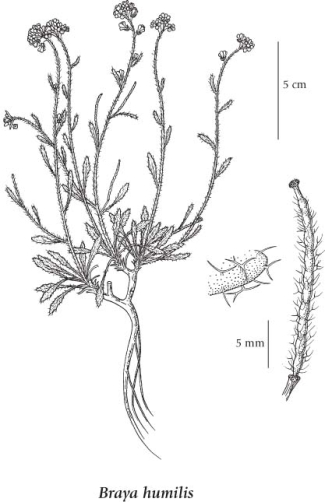Braya humilis (C.A. Mey.) B.L. Rob.
dwarf braya (low braya)
Brassicaceae (Mustard family)
Introduction to Vascular Plants
dwarf braya (low braya)
Brassicaceae (Mustard family)
Introduction to Vascular Plants
SUBTAXA PRESENT IN BC
Species Information
General:
Perennial or biennial from a taproot or stem-base; stems several, 5-30 cm long, erect or spreading, simple or branched, more or less hairy with forked hairs, purplish.
Leaves:
Basal leaves thick, linear-oblanceolate, 1-4 cm long, entire to somewhat toothed or wavy-margined, glabrous or somewhat hairy; stem leaves reduced, unstalked, lanceolate or linear, clasping at the bases.
Flowers:
Racemes somewhat headlike in flower, greatly elongated in fruit; flower stalks erect or closely ascending, 2-6 mm long, hairy; petals white or purplish, 3-4 mm long; sepals 1.5-2.5 mm long, hairy, deciduous;
Fruits:
Siliques, erect or closely ascending, 1-3 cm long, narrowly cylindric, about 1 mm wide, minutely hairy, somewhat constricted between the seeds; styles slender, 0.5-1 mm long; seeds in 1 row, 0.7-1 mm long.
Notes:
An adequate monograph of North American Braya (especially those of the far north) has yet to be done, thus our taxonomy of these species is often confusing.
Illustration

If more than one illustration is available for a species (e.g., separate illustrations were provided for two subspecies) then links to the separate images will be provided below. Note that individual subspecies or varietal illustrations are not always available.
Illustration Source: The Illustrated Flora of British Columbia
Ecology
Ecological Framework for Braya humilis
The table below shows the species-specific information calculated from
original data (BEC database) provided by the BC Ministry of Forests and Range.
(Updated August, 2013)
The table below shows the species-specific information calculated from
original data (BEC database) provided by the BC Ministry of Forests and Range.
(Updated August, 2013)
| Site Information |
Value / Class |
||
|
Avg |
Min |
Max |
|
| Elevation
(metres) |
1640 | 1250 | 2030 |
| Slope
Gradient (%) |
48 | 28 | 68 |
|
Aspect (degrees) |
337 | 45 | 270 |
| Soil
Moisture Regime (SMR) [0 - very xeric; 4 - mesic; 8 - hydric] |
2 | 2 | 3 |
| Modal
Nutrient Regime
Class |
|||
| #
of field plots species was recorded in: |
2 | ||
| Modal
BEC Zone Class |
MS | ||
|
All BEC Zones (# of stations/zone) species was recorded in |
MS(1) | ||
|
Source:
Klinkenberg 2013
|
|||